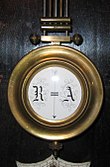Reglage
The regulator (French réglage ) or regulation referred to in the watch-making the fine adjustment of a clock to reduce the transition error . Usually the rule consists of observing and optimizing the daily rate in different positions and at different temperatures. The regulation of chronometers is mostly carried out by regulators . In addition to manual regulation, compensation mechanisms are often used for automatic regulation .
Small watches
The frequency of the balance can be adjusted by changing the effective length of the spring. In the simplest case, the balance spring is guided with its last turn between two pins that are attached to an adjustable lever. Turning the lever changes the effective length of the spring. This mechanism is called the Rücker . The regulator can be provided with a gooseneck or a micrometer adjusting screw for increased security and fine adjustment on portable watches . Below the needle there is a scale from A (French: avance for 'proceeding') to R (French: retard for 'following up'). The clock rate can be accelerated or slowed down by moving the needle in the respective direction. On clockworks for the English-speaking market, you can also find F ( fast ) and S ( slow ) here and there.
The watchmaker uses a timing machine to check the regulation and thus the accuracy , a device in which the vibration is measured and graphically displayed with a structure-borne sound microphone .
Position regulation
The location or position of a portable watch can have an impact on its accuracy. To compensate for such positional errors, a wristwatch can be adjusted in up to six positions ( crown on the left, crown on the right, crown above, crown below, dial below, dial above), e.g. B. in five layers with a COSC certification. For this purpose, the crown shaft of a clockwork can be hung on a gallows and the position of the clockwork can be adjusted.
Position errors can also be avoided in the course of a position compensation by constantly rotating the escapement and balance, such as B. in two dimensions with the tourbillon , the orbital tourbillon or the carousel (French caroussel ). Rotating in three dimensions, the escapement and balance are z. B. the gyroscope , the gyrotourbillon , the spherotourbillon or the triple-axis tourbillon . In the quadruple tourbillon , four tourbillons compensate for four positions.
Temperature regulation
In addition to the location, temperature fluctuations can also change the accuracy of a clockwork . In addition to temperature compensation, regulation at different temperatures (around 4, 20 and 36 ° Celsius) is another method for reducing the influence of changing temperatures.
Isochronism regulation
The spring of the balance wheel has an isochronous length that can also be adjusted.
Clocks
In pendulum clocks , the period of oscillation of a pendulum depends, among other things, on the gravity acting as a restoring force . Since gravity is a locally variable quantity, every change of location results in a systematic rate deviation. The length of a clock pendulum must therefore be adjusted to match the location.
With the help of the knurled regulating nut on the lower end of the pendulum rod, the pendulum body can be moved along the pendulum rod and thus the moment of inertia of the oscillating system that is appropriate for the local gravitational acceleration can be set. The regulation is usually carried out by the end user. In order to avoid incorrect operation, numerous manufacturers have added instructions on the direction of rotation of the regulating nuts. Frequent names are the letters R and A, borrowed from the French retarder (to slow down) and avancer (to accelerate). The arrow between the letters clearly shows where the watchmaker has to turn the knurled nut. The terms slow and fast are used for products for the anglophone market .
If you turn the regulating nut to the left in the direction of R, the pendulum becomes a little longer, which makes it swing a little slower. When turning to the right in direction A, however, the pendulum becomes a little shorter and the pendulum swings faster, which means that the clock goes a little faster. The regulating nuts are often secured against unintentional adjustment by a lock nut , which is turned down a few turns before the regulator and screwed back against the regulating nut after regulation. When turning the regulating nuts, in order to protect the sensitive pendulum suspension, the entire pendulum must never be twisted or taken out of its plane of oscillation .
literature
- Otto Böckle, Wilhelm Brauns: Textbook for the watchmaking trade. Work skills and materials. 8-10 Edition. Wilhelm Knapp, Halle (Saale) 1951 (reprint, edited by Michael Stern. Heel, Königswinter 2010, ISBN 978-3-86852-288-4 ).
- Hermann Brinkmann: Introduction to watchmaking (= The watchmaking school. Vol. 2). 10th unchanged edition. Wilhelm Knapp, Düsseldorf 2005, ISBN 3-87420-010-8 .
- George Daniels : Watchmaking. Updated 2011 edition. Philip Wilson Publishers, London 2011, ISBN 978-0-85667-704-5 .
- Ludwig Lossier: The regulation of the clocks in the positions. Presented in theory and practice. 2nd, unchanged edition. Huebner, Bautzen 1895.
Individual evidence
- ↑ Georges-Albert Berner: Illustrated specialist dictionary of watchmaking . Keyword regulation. (electronic version). Retrieved February 17, 2013.
- ^ Helmut Kahlert , Richard Mühe , Gisbert L. Brunner , Christian Pfeiffer-Belli: wrist watches: 100 years of development history. Callwey, Munich 1983; 5th edition, ibid 1996, ISBN 3-7667-1241-1 , p. 505.
- ↑ Georges-Albert Berner: Illustrated specialist dictionary of watchmaking . Keyword Rücker. (electronic version). Retrieved February 17, 2013.
- ↑ Georges-Albert Berner: Illustrated specialist dictionary of watchmaking . Keyword location. Retrieved March 12, 2013.


